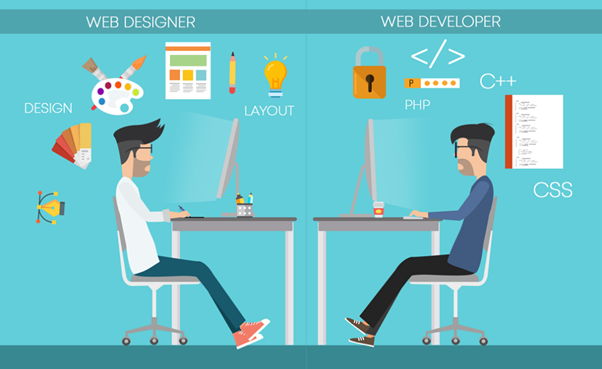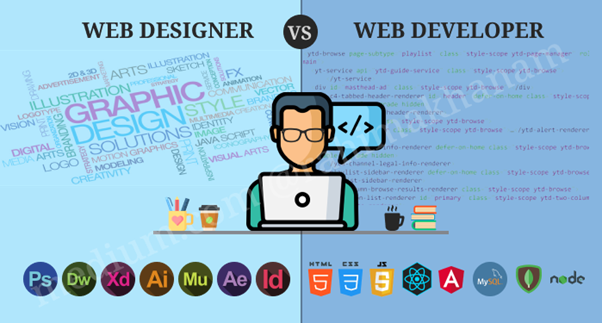
Web design rookies think there is a jack of all trades completing a website or a mobile app from scratch. Even if there is a team working on a large-scale project, many find it hard to understand what their roles and different spheres of responsibility are. So, it’s pretty easy to confuse web designers and developers; both work with websites and use specialized software.
But upon a closer look, you’ll see that designers and developers are responsible for completely different aspects of a website. The same applies to SaaS web design, so if you need a functional, good-looking web product, you will need both experts in the team. Here we examine the distinction between these two professions to simplify the choice of experts for your team.
The Distinction between Web Developers and Web Designers in a Nutshell
It may be easier for you to understand the difference between designers and developers if you compare website creation to construction. Suppose you’re tasked with building a house. In this case, a designer will be your architect; they will develop the overall concept, engineering structures, and the aesthetic look of your building overall. They are responsible for consistency in design and coherent match between all elements into a single, working whole.
In the same intellectual exercise, a web developer would be the person building the house using bricks and mortar, wooden and glass structures, and making sure it all stands on the base and doesn’t collapse. Similarly, the programmers are responsible for your website’s or app’s code, building every element and integrating it into a larger whole to make the digital product functional.
Duties of a Web Designer
Simply put, your web designer is responsible for the appealing looks of your website and its usability. They use visual design software, like Photoshop, Figma, or Sketch, to give the project a consistent feel and appearance, making the website more attractive to users.
However, it would be too simplistic to think about designers only in visual terms; their expertise goes far beyond drawing frames and choosing colors. The visual design they offer is mostly an outcome of extensive research, experimentation, and knowledge of user psychology.
Different Designers Do Different Work
Web designers can perform different roles in the project, such as:
- UX The UX design aspect is about the website’s usability. The web resource with high-quality UX should be convenient and usable for visitors, able to meet the user’s needs efficiently and without friction.
- UI UI stands for user interface, so this design aspect relates to the choice of text, imagery, and animation for simplified navigation. The interface also covers input controls, informational sections, and navigation components, making the use of the app beneficial.
- Visual This design type relates to the overall visual look of the digital product, with its consistency with the broader brand image in focus. The designer’s role is to choose colors, shapes, and menu positioning to achieve a positive visual effect.

Duties of a Web Developer
As for the web developer role, it’s more pragmatic in most web projects. The developer’s role is to make the design work in practice. Designers develop the concept of a website or app, showing where the menu components and visual elements should be positioned and how they should work. Thus, such experts program the code of a digital product to convert design ideas into a functioning product.
These experts use relevant programming languages and technologies to bring the design to life. This can be Javascript, Python, PHP, jQuery, CSS, etc., depending on the website’s purpose and combination of features. Still, web development is also divided into different aspects covered in the next section.
Front-end vs. Back-end Development
As a rule, coders are responsible for website architecture’s front-end and back-end parts. The web resource’s back-end part is its server-side portion, the core of any digital resource. The back-end is responsible for data storage, retrieval, and organization in the database. Users don’t see how the back-end works; it’s usually hidden from laypersons, giving them only the outcome of operations they activate by interacting with the UI, which is the resource’s front-end.
As for the front-end, it’s the user’s side of the app or website. It is built with usability and user-friendliness in mind, thus helping people without expert knowledge in coding interact with the digital resource. For instance, when you click on a product’s icon in the digital marketplace, you see the product description neatly presented to you in the form of a product card. That’s how the front-end works. But behind that simple action stands the retrieval of product data from a huge back-end database, which is the back-end of website operation.
Sometimes businesses have front-end and back-end developers in their team, especially if they handle large-scale projects and have plenty of work in each domain. But if your project is small in size, you may consider hiring a full-stack developer able to create the whole website from scratch. Such coders are skilled in both design aspects and can handle the back-end and front-end tasks equally well. The only problem is that such experts are a rare find in the labor market, and the rates they charge are often higher than those you would pay to two different experts.
Final Words
As you can see, digital product development is a multi-stage process that involves much work and requires different expertise. At first, you need to develop and validate the visual design concept, which lays the basis for further development and implementation. Thus, designers and developers get involved in the project at its various stages, coordinating distinct aspects of web design.
It may also be simpler to draw a divide between designers and coders by envisioning the first as creatives responsible for the website’s esthetics and the second – as technical implementers of visual ideas. The work of both is part and parcel of bringing a business idea to life with appealing, coherent, and functional web design solutions.
